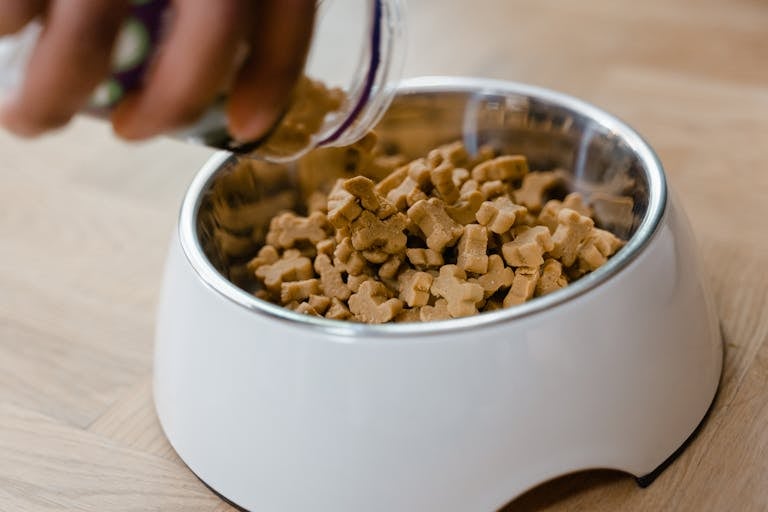8 Ways to Add More Protein to Your Dog’s Diet
We, dog parents, want our furry babies to be happy, healthy, and full of energy. One of the best ways to make that happen is by providing your pet with a balanced, protein-rich diet. You’ve likely heard this before: protein is the key cornerstone of canine nutrition and plays a vital role in building strong muscles, is a powerhouse energy source, aids skin and coat health and strengthens your pet’s immune system. While the benefits of this macronutrient are well-known, not many people are clear on the right way to add protein to a dog’s diet.
That’s because not all sources of protein are created equal. What you need is to offer your pet high-quality protein without exceeding their requisite caloric intake or compromising on well-rounded nutrition. Now, that can seem like a tricky balance to strike. You may find yourself wondering if you’re offering enough protein-rich foods to your dog or overdoing it.
Allow me to help with this detailed guide on practical ways to enhance your dog’s diet with protein-packed options. Whether you’re looking to make small tweaks to their meals or explore new feeding strategies, I’ve got you covered. But first, let’s talk in greater detail about why protein is so essential for dogs.
Table of Contents
Why Protein is Essential for Dogs
Anyone who has been on the pet parenting wagon long enough has probably heard the “feed your dog a protein-rich diet” advice. From vets to canine nutritionists and social media influencers, everyone seems to be advocating protein-rich foods for dogs. And you’ve probably done your best to figure out ways to increase your dog’s protein intake But have you stopped to wonder, why is that?
Is it just another fad or is there some reason behind it? Well, turns out, protein has a whole host of benefits for your canine companion. These include:
1. It aids muscle and tissue development
Protein is the building block for your dog’s muscles, tissues, organs, and skin. Dr. Jerry Klein, the American Kennel Club’s Chief Veterinary Officer, explains, “Proteins supply the essential amino acids necessary for a dog’s body to grow and repair itself, which is especially important for puppies and active breeds.” High-protein dog foods prevent muscle wasting and weakness, and go a long way in facilitating mobility even as your dog ages.
Suggested Reading: 7 Signs Your Dog’s Diet Needs an Upgrade
2. Protein strengthens the immune system
Another good reason to add protein to your dog’s diet is that it plays a key role in maintaining a robust immune system, specifically in production of antibodies that fight off infections and diseases. According to the Journal of Animal Science, dogs with higher protein diets show improved immune responses.
3. It promotes healthy skin and shiny coat
Want to know the secret to keeping your dog’s fur shiny and their skin free of issues like itchiness and flaking? Yep, you guessed it: it’s protein. Protein aids the production of keratin, the main structural component in your dog’s fur. Dr. Ernie Ward, a veterinary author and founder of the Association for Pet Obesity Prevention, notes that “a high-quality protein diet contributes to a healthy, lustrous coat that can make a dog look and feel its best.”
4. It’s a primary source of energy for Active Dogs
Protein not just helps build muscles but is also a crucial energy source for dogs, as they break down protein for sustained energy. A protein-rich diet is especially crucial for high-energy breeds and dogs with active lifestyles. Research from the Waltham Petcare Science Institute has shown that active dogs on high-protein diets have better endurance and quicker recovery times after physical activity.
5. A protein-rich diet leads to better digestive health
High-quality protein-rich foods for dogs are also recommended because they are easier to digest, making nutrient absorption more efficient. Dr. Jean Hofve, a holistic veterinarian, explains, “Digestibility of protein sources is critical, as it ensures your dog’s body is actually utilizing the nutrients you’re feeding them.”
Quality high-protein dog foods can not only promote digestive health but can also be used to address digestive issues. Veterinarians often recommend easily digestible proteins like chicken and fish for dogs with sensitive stomachs.
6. Protein also aids in hormone and enzyme production
In addition to aiding muscle growth, providing energy, strengthening the immune system, and contributing to skin and gut health, protein is also vital for producing enzymes and hormones that regulate everything from metabolism to digestion. Canine nutrition expert Dr. Richard Hill explains, “A balanced protein intake helps maintain stable hormone levels, which is crucial for overall health, especially as dogs age.”
Suggested Reading: 12 Dog Food Ingredients Bad for Your Pet’s Health and Longevity
7. It helps with weight management
For dogs prone to weight gain—yes, I’m talking about you, Labradors—protein can help by promoting satiety, making them feel full longer. Besides, protein requires more energy to digest, which can help in maintaining a healthy weight. Studies published in the Journal of Veterinary Internal Medicine suggest that diets rich in lean protein can aid in weight control, especially when combined with an active lifestyle.
Watch the video below for more insights:
8 Ways to Add More Protein to Your Dog’s Diet
Now that we’ve covered all the ways protein can be beneficial for your furry baby, let’s circle back to the query at hand: how can you add more protein to your dog’s diet? Turns out, it’s not challenging at all. From tasty treats to nutritious toppers and protein-centric meals, there are plenty of healthy ways to increase your dog’s protein intake. Here are eight options your can explore
1. Lean meats like chicken or turkey
Lean meats like chicken and turkey are the best high-protein foods for dogs. So, if you’re looking to increase your pet’s protein intake, one of the simplest ways to do it is incorporating unseasoned but cooked and deboned poultry to their meals. Dr. Susan Wynn, a board-certified veterinary nutritionist, says, “Chicken and turkey provide high-quality protein that is easily digestible and can be suitable for dogs with sensitive stomachs.”
2. Eggs are a complete protein source
If you’re looking for natural ways to add more protein to dog food, you just cannot overlook eggs, a powerhouse of protein and also a rich source of essential nutrients like Vitamin B12, riboflavin, and selenium.
Veterinary nutritionist Dr. Karen Becker recommends eggs, saying, “Eggs are one of the most bioavailable protein sources for dogs, meaning they’re easy to digest and absorb.” Besides, they’re readily available and easy to incorporate in your pet’s meals. You can offer boiled eggs as a midday snack (my dog loves it) or scramble them (without oil or seasoning) and add as a topping on your dog’s food.
3. Cottage cheese or greek yogurt for a mix of protein and probiotics boost
Dairy products like plain cottage cheese or Greek yogurt are not only protein-rich foods for dogs but also a great source of probiotics that support your dog’s gut health. These, too, can be served as a topping on your dog’s food or offered as a snack. Cottage cheese cut in small cubes also makes for a great treat. Just make it a point to choose plain, unsweetened, and low-fat variants. Also, since not all dogs handle dairy well, it’s best to introduce these foods slowly and see how your pet’s digestive system responds.
4. Fish is a great source of protein and Omega-3s
If you make smart choices about your dog’s diet, you won’t have to look for dog diet protein supplements to make sure their nutritional needs are met. One such smart choice is feeding your dog fish like salmon, sardines, and mackerel, all of which are protein-rich and packed with omega-3 fatty acids that support skin, coat, and joint health.
Veterinarian Dr. Ernie Ward explains, “Fish provides lean protein and anti-inflammatory omega-3s, which are particularly beneficial for older dogs or those with arthritis.” However, raw fish isn’t suitable for dogs, so make sure you cook it well, and serve it without any seasonings or bones. A portion of cooked fish can be a tasty meal topper, and you can easily offer it to your pet once or twice a week.

5. Organ meats are a nutrient-dense protein option
Organ meats like liver, kidney, or heart may not exactly seem palatable to you but your dog will lap them up and they’re a great source of protein as well as essential vitamins and minerals.
Dr. Karen Shaw Becker, a holistic vet, highlights the nutritional power of organ meats, saying, “Organs like liver are nutrient-dense and a great source of protein, but they should be served in moderation.” Organ meats are best used as meal toppers or treats in cooked form and small quantities, as too much of them can lead to digestive issues.
6. High-quality packaged toppers and mix-ins
While there is no dearth of options for homemade protein-rich meals for dogs (or even protein-rich additives to dog meals), not everyone has the time to prep, cook, and serve nutritionally balanced home cooked meals to their pets. If that’s you, high-quality packaged kibble toppers or mix-ins made with freeze-dried meat or fish can be a great option to add more protein to your dog’s diet.
Given that there are so many options, how do you pick the right one? Veterinary nutritionist Dr. Jennifer Larsen recommends, “Look for high-quality toppers made from single protein sources and free of fillers for an easy, convenient boost.” It’s also vital that in the interest of increasing protein in dog food, you don’t end up overfeeding your pet. So, make sure you follow the package guidelines on quantities or speak to your vet or a canine nutritionist about adjusting food portions to make space for these toppers without shooting up your pet’s caloric intake.
7. Bone broth is another nutritious protein add-on
Bone broth is also rich in collagen, which supports joint health, and adds a mild amount of protein that can make your dog’s meal extra tasty and nutritious. Dr. Cathy Alinovi, a holistic vet, “Bone broth is a gentle, protein-packed addition that provides hydration and can entice picky eaters.” It also works as a wonderful alternative to regular meals when your dog is sick or suffering from digestive distress.
It’s best to give your pet bone broth prepared at home, without any salt or onions, which are toxic to dogs. Store-bought varieties are best avoided as they contain additives that may be harmful to your pet.
Suggested Reading: Can Dogs Eat Dragon Fruit?
8. Lentils or quinoa for a meat-free protein boost
If you’re looking to add variety to your dog’s diet, plant-based options like lentils and quinoa can be great choices for increasing protein in dog food. Apart from being rich in protein, these also contain fiber, making them easy to digest. Just cook lentils or quinoa thoroughly (without any seasoning) and add a small portion to your dog’s meal.
Dr. Cailin Heinze, a veterinary nutritionist, explains, “For dogs that may not tolerate certain animal proteins, lentils or quinoa are excellent alternatives that still offer protein.” These are also a great way of offering your pet a diverse and balanced diet.
FAQs
- How do I know if my dog needs more protein?
A lack of energy, muscle loss, dull coat, or even flaky skin can be indicators of low protein intake. Dr. Jerry Klein, Chief Veterinary Officer at the American Kennel Club, says, “Protein supports muscle tone, skin health, and immune function, so changes in these areas could suggest a protein deficiency.” If you notice any of these symptoms, consult your vet to adjust their diet.
- Can too much protein be harmful to my dog?
Yes, too much protein can be harmful to some dogs, especially those with kidney or liver issues. Excess protein can strain these organs, as they have to work harder to process it. For healthy dogs, a high-protein diet is generally safe, but it’s always best to consult your vet before making any changes. They can help determine the ideal protein level for your dog’s age, breed, and health needs.
- Are there vegetarian or vegan protein sources for dogs?
Yes, lentils, chickpeas, quinoa, and certain vegetables can be good plant-based protein sources, however, they don’t quite match the amino acid profile of meat. If you’re considering a vegetarian or vegan diet for your dog, it’s best to consult your vet or a pet nutritionist. They can help you create a well-rounded, balanced diet that meets your dog’s protein and nutritional needs.
- Can I add raw meats to increase protein in my dog’s diet?
Adding raw meats to your dog’s diet requires caution. Raw diets have benefits, but they also carry risks like bacterial contamination that can affect your dog as well as people in your household. Dr. Karen Becker, a holistic vet, suggests, “If you choose raw, make sure it’s fresh, high-quality, and handled properly.”
- What’s the best protein source for senior dogs?
For senior dogs, high-quality, easily digestible protein sources are best. Options like lean chicken, turkey, and eggs are ideal because they provide essential amino acids without straining the digestive system. Fish, like salmon, can also be a good choice, adding joint-friendly omega-3s.
Takeaway
The bottom line is, protein is more than just a nutrient for your dog—it’s a cornerstone of their health and well-being. While dogs do need other nutrients like carbohydrates, fiber, and healthy fats in their diet, protein has to be the pivotal ingredient of their diet and must never be compromised on. And remember, when in doubt about your dog’s nutritional needs, consult your vet or a certified canine nutritionist to make sure your pet’s diet aligns is suited to their age, breed, and activity level for optimal health.







